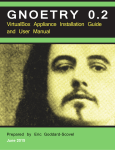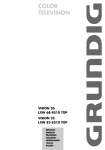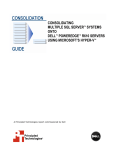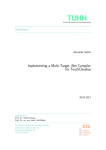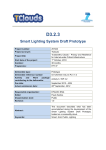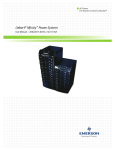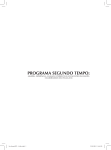Download Cracking the 500-Language Problem programming languages
Transcript
feature
programming languages
Cracking the
500-Language Problem
Ralf Lämmel and Chris Verhoef, Free University of Amsterdam
Parser
implementation
effort dominates
the construction
of software
renovation tools
for any of the
500+ languages
in use today. The
authors propose
a way to rapidly
develop suitable
parsers: by
stealing the
grammars.
They apply this
approach to
two nontrivial,
representative
languages, PLEX
and VS Cobol II.
78
IEEE SOFTWARE
t least 500 programming languages and dialects are available in
commercial form or in the public domain, according to Capers
Jones.1 He also estimates that corporations have developed some
200 proprietary languages for their own use. In his 1998 book on
estimating Year 2000 costs, he indicated that systems written in all 700 languages would be affected.2 His findings inspired many Y2K whistle-blowers
to characterize this situation as a major impediment to solving the Y2K
A
problem; this impediment became known
as the 500-Language Problem.
In 1998, we realized that we had discovered a breakthrough in solving the 500LP—
so we had something to offer regarding the
Y2K problem. We immediately informed all
the relevant Y2K solution providers and people concerned with the Y2K awareness campaign. In answer to our emails, we received a
boilerplate email from Ed Yourdon explaining that the 500LP was a major impediment
to solving the Y2K problem (which we knew,
of course). Ed was apparently so good at creating awareness that this had backfired on
him: he got 200 to 300 messages a day with
Y2K questions and was no longer able to
read, interpret, and answer his email other
than in “write-only” mode. Although he presumably missed our input, his response regarding the 500LP is worth quoting:
November/December 2001
I recognize that there is always a chance that
someone will come up with a brilliant solution that everyone else has overlooked, but at
this late date, I think it’s highly unlikely. In
particular, I think the chances of a “silver bullet” solution that will solve ALL y2k problems
is virtually zero. If you think you have such a
solution, I have two words for you: embedded
systems. If that’s not enough, I have three
words for you: 500 programming languages.
The immense variety of programming languages (yes, there really are 500!), hardware
platforms, operating systems, and environmental conditions virtually eliminates any
chance of a single tool, method, or technique
being universally applicable.
The number 500 should be taken poetically, like the 1,000 in the preserving
process for so-called 1,000-year-old eggs,
which last only 100 days. For a start, we
0740-7459/01/$10.00 © 2001 IEEE
should add the 200 proprietary languages.
Moreover, other estimates indicate that 700
is rather conservative: in 1971, Gerald
Weinberg estimated that by the following
year, programming languages would be invented at the rate of one per week—or
more, if we consider the ones that never
make it to the literature, and enormously
more if we consider dialects.3
Peter de Jager also helped raise awareness of the 500LP. He writes this about the
availability of Y2K tools:4
There are close to 500 programming languages used to develop applications. Most of
these conversion or inventory tools are directed toward a very small subset of those 500
languages. A majority of the tools are focused
on Cobol, the most popular business programming language in the world. Very few tools, if
any, have been designed to help in the area of
APL or JOVIAL for example.
If everyone were using Cobol and only a
few systems were written in uncommon
languages, the 500-Language Problem
would not be important. So, knowing the
actual language distribution of installed
software is useful. First, there are about
300 Cobol dialects, and each compiler
product has a few versions—with many
patch levels. Also, Cobol often contains
embedded languages such as DMS, DML,
CICS, and SQL. So there is no such thing as
“the Cobol language.” It is a polyglot, a
confusing mixture of dialects and embedded languages—a 500-Language Problem
of its own. Second, according to Jones, the
world’s installed software is distributed by
language as follows:
■
■
■
■
Cobol: 30 percent (225 billion LOC)
C/C++: 20 percent (180 billion LOC)
Assembler: 10 percent (140 to 220 billion LOC)
less common languages: 40 percent (280
billion LOC)
In contrast, there were Y2K search engines for only about 50 languages and automated Y2K repair engines for about 10 languages.2 Thus, most languages had no
automated modification support, clarifying
the concerns of Jones, Yourdon, McCabe,
de Jager, and others. These alarming figures
underscored the 500LP’s importance.
What is the 500-Language
Problem?
We entered the new millennium without
much trouble, so you might conclude that
whatever the 500LP was, it is not relevant
now. Of course, the problem existed before
the Y2K gurus popularized it, and it has not
gone away.
Why is the problem still relevant? If you
want tools to accurately probe and manipulate source code, you must first convert the
code from text format to tree format. To do
this, you need a so-called syntactic analyzer,
or parser. But constructing a parser is a major effort, and the large up-front investment
hampers initiatives for many commercial
tool builders. Indeed, a few years ago Tom
McCabe told us that his company, McCabe
& Associates, had made a huge investment
in developing parsers for 23 languages. Noting that 500 would be insurmountable, he
dubbed this problem “the number one
problem in software renovation.” Thus, the
500LP is the most prominent impediment to
constructing tools to analyze and modify
existing software assets. Because there are
about a trillion lines of installed software
written in myriad languages, its solution is a
step forward in managing those assets.
Solutions that don’t work
A solution sometimes suggested for the
500LP is just to convert from uncommon
languages to mainstream ones for which
tool support is available. However, you
need a full-blown tool suite—including a serious parser—to do this. And obtaining a
parser is part of the 500LP. So language
conversion will not eliminate the problem—
on the contrary, you need a solution for the
500LP to solve conversion problems.
A Usenet discussion on comp.compilers
offered a second suggestion to solve the
500LP: generating grammars from the
source code only, in the same way linguists
try to generate a grammar from a piece of
natural language. In search of solutions, we
studied this idea and consulted the relevant
literature. We did not find any successful effort where the linguistic approach helped to
create a grammar for a parser in a costeffective way. We concluded that the linguistic approach does not lead to useful
grammar inferences from which you can
build parsers.5
November/December 2001
IEEE SOFTWARE
79
Tool 1
Tool 2
Pretty
printer
Parser
Grammar
Grammar
...
Tree
walker
Generic
core
Analyzer
...
Editor
Tool
n
Figure 1. Effort shift for renovation tool development. The
longer the arrow, the more effort is needed. The dashed
line represents the greater effort needed if the traditional
approach is used.
Another, more reasonable suggestion is to
reuse the parser from compilers: just tap a
compiler’s parser output and feed it to a
modification tool. Prem Devanbu’s programmable GENOA/GENII tool can turn a
parser’s idiosyncratic output format into a
more suitable format for code analysis.6
There is, however, one major drawback to
this approach: as Devanbu points out, the
GENOA system does not allow code modification. This is not a surprise: a compiler’s
parser removes comments, expands macros,
includes files, minimizes syntax, and thus irreversibly deforms the original source code.
The intermediate format is good enough for
analysis in some cases, but the code can
never be turned into acceptable text format
again. Hence, the approach does not help
regarding mass modifications, for which the
Gartner Group recommends tool support to
handle a larger code volume.7,8 Obviously,
this concerns Y2K and Euro conversions,
code restructuring, language migrations, and
so on. Another real limitation of Devanbu’s
approach is that, even if you only want to do
code analysis, you often cannot get access to
a compiler company’s proprietary source.
How we are cracking the 500LP
Recall that Yourdon claimed that the
large number of programming languages
would virtually eliminate any chance of a
single tool, method, or technique being universally applicable. Nevertheless, there is a
single, feasible solution for the 500LP. It is
80
IEEE SOFTWARE
November/December 2001
cracked when there is a cheap, rapid, and reliable method for producing grammars for
the myriad languages in use so that existing
code can be analyzed and modified. Cheap is
in the US$25,000 ± $5,000 range, rapid is in
the two-week range (for one person), and reliable means the parser based on the produced grammar can parse millions of LOC.
Why is this a solution? A grammar is
hardly a Euro conversion tool or a Y2K analyzer. It is because the most dominant factor in building renovation tools is constructing the underlying parser.
From grammar to renovation tool
Renovation tools routinely comprise the
following main components: preprocessors,
parsers, analyzers, transformers, visualizers,
pretty printers, and postprocessors. In many
cases, language-parameterized (or generic)
tools are available to construct these components. Think of parser generators, prettyprinter generators, graph visualization
packages, rewrite engines, generic dataflow
analyzers, and the like. Workbenches providing this functionality include Elegant,
Refine, and ASF+SDF, for instance, but
there are many more.
Figure 1 depicts a grammar-centric approach to enabling rapid development of
renovation tools. Arrow length indicates the
degree of effort involved (longer arrows imply more effort). As you can see, if you have
a generic core and a grammar, it does not
take much effort to construct parsers, tree
walkers, pretty printers, and so on. Although these components depend on a particular language, their implementation uses
generic language technology: a parser is produced using a parser generator, a pretty
printer is created using a formatter generator,9 and tree walkers for analysis or modification are generated similarly.10 All these
generators rely heavily on the grammar.
Once you have the grammar and the relevant generators, you can rapidly set up this
core for developing software renovation
tools. Leading Y2K companies indeed constructed generic Y2K analyzers, so that dealing with a new language would ideally reduce to constructing a parser. The bottleneck
is in obtaining complete and correct grammar specifications. The longest arrow in Figure 1 expresses the current situation: it takes
a lot of effort to create those grammars.
Implementing a high-quality Cobol parser
can take two to three years, as Vadim Maslov
of Siber Systems posted on the Usenet newsgroup comp.compilers (he has constructed
Cobol parsers for about 16 dialects). Adapting an existing Cobol parser to cope with
new dialects easily takes three to five months.
Moreover, patching existing grammars using
mainstream parser technology leads to unmaintainable grammars,11,12 significantly increasing the time it takes to adapt parsers. In
contrast, Table 1 lists the effort expended on
various phases of a typical Cobol renovation
project that used our grammar-centric solution. Notice that the grammar part of this
project took only two weeks of effort, so the
team could start developing actual renovation tools much more quickly.
This Cobol renovation project concerned
one of the world’s largest financial enterprises, which needed an automatic converter from Cobol 85 back to Cobol 74 (the
8574 Project).13 The Cobol 85 code was machine-generated from a fourth-generationlanguage tool, so the problem to convert
back was fortunately restricted due to the
code generator’s limited vocabulary. It took
some time to solve intricate problems, such
as how to simulate Cobol 85 features like
explicit scope terminators (END-IF, ENDADD) and how to express the INITIALIZE
statement in the less-rich Cobol 74 dialect.
The developers discussed solutions with the
customer and tested them for equivalence.
Once they solved these problems, implementing the components was not difficult
because they had the generic core assets generated from a recovered Cobol 85 grammar.
They cut the problem into six separate tools
and then implemented all of them in only
five days. The programming by hand was
limited (fewer than 500 LOC), but compiled
into about 100,000 lines of C code and
5,000 lines of makefile code (linking all
Table 1
Effort for the 8574 Project
Phase
Effort
Extract the grammar
Generate the parser
Build six tools
Assemble all the components
Total
Two weeks
One day
Five days
One hour
Three weeks
the generated generic renovation functionality). After compilation to six executables
(2.6 Mbytes each), it took 25 lines of code
to coordinate them into a distributed, component-based software renovation factory,
which then converted Cobol 85 code to
Cobol 74 at a rate of 500,000 LOC per
hour using 11 Sun workstations.
Measuring this and other projects, it became clear to us that the total effort of writing a grammar by hand is orders of magnitude larger than constructing the renovation
tools themselves. So the dominant factor in
producing a renovation tool is constructing
the parser. Building parsers using our approach reduces the effort to the same order
of magnitude as constructing the tools. Building parsers in turn is not hard: use a parser
generator. But the input for the generator is a
grammar description, so complete and correct grammars are the most important artifacts we need to enable tool support. When
we find an effective solution for producing
grammars quickly for many languages, we
have solved the 500LP.
But how do we produce grammars
quickly? For years, we and many others have
been recapturing an existing language’s syntax
by hand: we took a huge amount of sources,
manuals, books, and a parser generator and
started working. But then we realized that this
hand work is not necessary. Because we are
dealing with existing languages, we just steal
and massage the underlying grammars according to our needs.
When we find
an effective
solution for
producing
grammars
quickly for
many languages,
we have solved
the 500LP.
Grammar stealing covers almost all languages
The following exhaustive case distinction
shows that our approach covers virtually all
languages. Let’s look at the coverage diagram
for grammar stealing shown in Figure 2. Because the software we want to convert already exists, it can be compiled or interpreted.
We first enter the Compiler Sources diamond.
There are two possibilities: the source code is
or is not available to you. If it is, you just have
to find the part that turns the text into an intermediate form. That part now contains the
grammar in some form. You do this by lexically searching the compiler source code for
the language’s keywords.
Compiler constructors implement a
parser in one of three ways: they hard-code
it, use a parser generator, or do both (in a
complex multilanguage compiler, for inNovember/December 2001
IEEE SOFTWARE
81
No
Start
Compiler
sources?
Hard-coded
parser
Quality?
One case:
perl
Yes
Yes
Recover the
grammar
BNF
No
No
Language
reference
manual?
General
rules
Yes
Recover the
grammar
Quality?
Constructions
by example
No cases
known
Yes
Recover the
grammar
One case:
RPG
No
No cases known
Figure 2. Coverage diagram for grammar stealing.
stance). Figure 2 shows the first two cases—
the third is just a combination. If you start
with a hard-coded grammar, you must reverse-engineer it from the handwritten code.
Fortunately, the comments of such code often include BNF rules (Backus Naur Forms)
indicating what the grammar comprises.
Moreover, because compiler construction is
well-understood (there is a known reference
architecture), compilers are often implemented with well-known implementation algorithms, such as a recursive descent algorithm. So, the quality of a hard-coded parser
implementation is usually good, in which
case you can easily recover the grammar
from the code, the comments, or both. Except in one case, the Perl language,14 the
quality of the code we worked with was always sufficient to recover the grammar.
If the parser is not hard-coded, it is generated (the BNF branch in Figure 2), and
some BNF description of it must be in the
compiler source code. So, with a simple tool
that parses the BNF itself, we can parse the
BNF of the language that resides in the compiler in BNF notation, and then extract it.
When the compiler source code is not
accessible (we enter the Language Reference Manual diamond in Figure 2), either a
reference manual exists or not. If it is available, it could be either a compiler vendor
manual or an official language standard.
The language is explained either by exam82
IEEE SOFTWARE
November/December 2001
ple, through general rules, or by both approaches. If a manual uses general rules, its
quality is generally not good: reference
manuals and language standards are full of
errors. It is our experience that the myriad
errors are repairable. As an aside, we once
failed to recover a grammar from the manual of a proprietary language for which the
compiler source code was also available
(so this case is covered in the upper half of
Figure 2). As you can see in the coverage
diagram, we have not found low-quality
language reference manuals containing
general rules for cases where we did not
have access to the source code. That is, to
be successful, compiler vendors must provide accurate and complete documentation, even though they do not give away
their compilers’ source code for economic
reasons. We discovered that the quality of
those manuals is good enough to recover
the grammar. This applies not only to compiler-vendor manuals but also to all kinds
of de facto and official language standards.
Unusual languages rarely have high-quality
manuals: either none exists (for example, if
the language is proprietary) or the company
has only a few customers. In the proprietary
case, a company is using its in-house language and so has access to the source code;
in the other case, outsiders can buy the code
because its business value is not too high.
For instance, when Wang went bankrupt, its
key customers bought the source code for its
operating system and compilers to create
their own platform and dialect migration
tools. This explains why we do not know of
low-quality manuals containing general
rules. In one case, that of RPG, the manual
explains the language through code examples, and general rules are absent. We can
examine this case in more detail if we are
asked for an RPG renovation project involving a large amount of RPG code. We
think we can systematically extract RPG’s
general rules from the code examples.
In addition, because the manual contains
code examples, there is a good chance that
the compiler has tested these examples. This
means that the manual’s formal content
could be of a much higher quality than you
would expect from such documents.
Finally, we must deal with the case in
which we have no access to the compiler
sources or a reference manual. Capers Jones
mailed us that “for a significant number of
applications with Y2K problems, the compilers may no longer be available either because the companies that wrote them have
gone out of business or for other reasons.”
He did not come up with actual examples.
Recall Wang’s bankruptcy: key customers
just bought the source code and hence could
solve their problems using the upper half of
Figure 2. Theoretically, we cannot exclude
Jones’s case—for instance, responding emotionally, Wang’s core developers could have
thrown away the sources. You can learn an
important lesson from this: Contracts between you and the vendor of a business-critical language should include a solution for
source access in case of bankruptcy or terminated support (for example, giving the sealed
source code to key customers). Summarizing,
our coverage diagram shows that you can recover virtually any grammar, whether you
have the compiler sources or not.
But what about semantics?
Some people think you need up-front, indepth knowledge of a language’s semantics
to change code. If you recover the BNF, you
can generate a syntax analyzer that produces
trees, but the trees are not decorated with
extra knowledge such as control flow, data
flow, type annotation, name resolution, and
so on. Some people also think you need a lot
of semantical knowledge to analyze and
modify existing software, but this is not true.
You can try to capture a language’s semantical knowledge on three levels:
■
■
■
for all the compilers of a language (different dialects),
for one compiler product, or
on a project-by-project basis.
Because we are trying to facilitate the
construction of tools that work on existing
software, there is already a compiler. This
has implications for dealing with the semantical knowledge. Consider the following Cobol excerpt:
Some people
think you need
up-front,
in-depth
knowledge of
a language’s
semantics to
change code.
PIC A X(5) RIGHT JUSTIFIED
VALUE ’IEEE’.
DISPLAY A.
The OS/VS Cobol-compiled code prints the
expected result—namely, “ IEEE”—which is
right justified. However, because of a change
in the 1974 standard, the same code compiled with a Cobol/370 compiler displays the
output “IEEE ” with a trailing space, which
is left justified. This is because the RIGHT
JUSTIFIED phrase does not affect VALUE
clauses in the case of the Cobol/370 compiler. There are many more such cases, so
trying to deal with the semantics of all compilers in advance is not feasible. Even when
you restrict yourself to one compiler, this
problem does not go away. Consider this
Cobol fragment:
01 A PIC 9999999.
MOVE ALL ’123’ to A.
DISPLAY A.
Depending on the compiler flags used to
compile this code, the resulting executables
display either 3123123 or 1231231. There
are hundreds of such problems, so it is also
infeasible to capture the semantics in advance for a single compiler. No single semantics is available, and gathering all variants is prohibitively expensive and error
prone given the semantical differences between compilers, compiler versions, and
even compiler flags used.
The good news is that you only need specific ad hoc elements of the semantics on a
per-project basis. We call this demand-driven
semantics. For instance, the NEXT SENTENCE
November/December 2001
IEEE SOFTWARE
83
We recovered
the PLEX
grammar
in two weeks,
including tool
construction,
parser
generation,
and testing,
at a cost of
US$25,000.
84
IEEE SOFTWARE
(a)
IF X=1 THEN
IF Y=1 THEN
NEXT SENTENCE
END-IF
DISPLAY ’Nested IF passed’
END-IF.
DISPLAY ’SENTENCE passed’.
(b)
IF X=1 THEN
IF Y=1 THEN
CONTINUE
END-IF
DISPLAY ’Nested IF passed’
END-IF.
DISPLAY ’SENTENCE passed’.
Figure 3. A code segment (a), transformed inappropriately into the code
segment in (b). The change in line 3 results in wrong output.
phrase in Cobol directs control to the statement after the next separation period (denoted with a dot). So, depending on where
people put a dot, the code jumps directly behind the dot. Omitting a dot can lead to different behavior. One of our customers
wanted tools to get rid of this potentially
hazardous implicit jump instruction. Luckily, it turned out that for this project, we
could replace the implicit jump instruction
NEXT SENTENCE with the innocent no-op
CONTINUE. So, after our semantical investigation, we knew we could use a simple
transformation tool to make this change.
However, in another project, this transformation might break down—for example, if
the NEXT SENTENCE phrase is used in problematic code patterns. The transformation of
the code in Figure 3a into the code in Figure
3b has changed the program’s meaning: you
cannot turn NEXT SENTENCE into CONTINUE
in the context of Figure 3. Specifically, assuming both X and Y are equal to 1, the code
in Figure 3a prints “SENTENCE passed”
while the code in Figure 3b prints first
“Nested IF passed” and then “SENTENCE
passed”. As you can see, you must be utterly
aware of the semantics to find out whether it
is necessary to implement any of it. In most
cases we have seen, implementing this type
of intricate semantical issue was not necessary—but knowing about the potential
problems was necessary, if only to check
whether they were present.
To give you an idea how far you can go
with demand-driven semantics, consider this:
we have developed relatively dumb tools for
some Cobol systems that can wipe out complex GO TO logic.15 You do need to know the
semantics for many different tasks, but it is
not necessary in advance to encode the compiler semantics in a parse tree or otherwise.
So, a tool developer can construct (mostly)
syntactic tools taking semantical knowledge
into account on a per-project basis.
November/December 2001
Grammar stealing in practice
We—and others from industry and academia—have applied grammar stealing
successfully to a number of languages, including Java, PL/I, Ericsson PLEX, C++,
Ada 95, VS Cobol II, AT&T SDL, Swift
messages, and more. Here, we focus on
PLEX (Programming Language for Exchanges), a proprietary, nontrivial, realtime embedded-system language (for which
the compiler source code was accessible to
us), and, at the other end of the gamut, VS
Cobol II, a well-known business language
(for which no compiler code was available). Both languages are used in businesscritical systems: the AXE 10 public branch
exchange uses PLEX, and numerous IBM
mainframe systems run VS Cobol II. These
two languages represent the two main
branches in Figure 2.
Our approach uses a unique combination
of powerful techniques:
■
■
■
■
automated grammar extraction,
sophisticated parsing,
automated testing, and
automated grammar transformation.
If one of these ingredients is missing, the synergy is gone. Extraction by hand is error
prone, and basic parsing technology limits
you to work with grammars in severely limited formats. With powerful parsing technology, you can work with arbitrary context-free
grammars and test them regardless of their
format. Without automated testing, you cannot find many errors quickly. Without tool
support to transform grammar specifications,
analyses are inaccurate and corrections are inconsistent; without transformations, you cannot repeat what you have done or change initial decisions easily. So, to steal grammars,
you need to know about grammars, powerful
parsing techniques, how to set up testing, and
automated transformations.
<plex-program>
= <program-header> <statement-row> ’END’ ’PROGRAM’ ’;’
%% xnsmtopg(1) ; %%
-<= sect
-Compound(
-Reverse(STATEMENT-ROW.stat_list) =>
-PROGRAM-HEADER.sect.as_prog_stat : ix_stat_list_p
-PROGRAM-HEADER.sect : ix_sect_node_p)
;
Figure 4. Raw compiler source code for the PLEX language.
Stealing from compiler source code
Ericsson uses the extremely complex proprietary language PLEX to program public
telephone switches. PLEX consists of about
20 sublanguages, called sectors, including
high-level programming sectors, assembly
sectors, finite-state-machine sectors, marshaling sectors, and others. We applied our grammar-stealing approach to PLEX as follows:16
1. Reverse-engineer the PLEX compiler
(63 Mbytes of source code) on site to
look for grammar-related files. We
learned that there were BNF files and a
hard-coded parser.
2. Find the majority of the grammars in
some BNF dialect.
3. Find a hand-written proprietary assembly parser with BNF in the comments.
4. Write six BNF parsers (one for each
BNF dialect used).
5. Extract the plain BNF from the compiler sources and convert it to another
syntax definition formalism (SDF) for
technical reasons.
6. Find the files containing the lexical analyzer and convert the lexical definitions to SDF.
7. Combine all the converted grammars
into one overall grammar.
8. Generate an overall parser with a sophisticated parser generator.
9. Parse the code.
We recovered the PLEX grammar in two weeks,
including tool construction, parser generation,
and testing with 8-MLOC PLEX code, at a cost
of US$25,000. Ericsson told us that a cuttingedge reengineering company had estimated this
task earlier at a few million dollars. When we
contacted this company, they told us that
US$25,000 was nothing for such a grammar.
To illustrate the limited complexity of the
work, consider the fragment of raw com-
piler source code in Figure 4. A PLEX program consists of a header, a list of statements, the phrase END PROGRAM, and a closing semicolon. The other code in the figure
deals with semantic actions relevant to the
compiler. Our tools converted this to a common BNF while removing the idiosyncratic
semantic actions:
The tools
we built
automatically
recovered
most of the
3,000+
production
rules in an
afternoon.
plex-program ::= program-header
statement-row
’END’ ’PROGRAM’ ’;’
Then our tools converted this into SDF,
which was subsequently fed to a sophisticated parser generator accepting arbitrary
context-free grammars. The output was
Program-header
Statement-row
”END” ”PROGRAM” ”;” -> Plex-program
The tools we built automatically recovered most of the 3,000+ production rules in
an afternoon. Then we tested each sector
grammar separately. We used a duplicate
detector to weed out production rules that
were used in more than one sector grammar,
so that we could construct an overall grammar able to parse complete PLEX programs.
One assembly sector parser was hard-coded
(see Figure 2), so we had to recover its
grammar through reverse engineering. The
comments accompanying the code contained reasonably good BNF, so we had no
problem with this task. With all the sector
grammars combined, we generated a parser
to test it with an 8-MLOC PLEX test suite.
The only files that did not parse were compiler test files that were not supposed to
parse—the rest passed the test. In addition,
we generated a Web-enabled version of the
BNF description as a basis for a complete
and correct manual.
November/December 2001
IEEE SOFTWARE
85
3.30 SEARCH Statement
___ Format 1--Serial Search _____________________________________
|
|
| >>__SEARCH__identifier-1______________________________________> |
|
|_VARYING____identifier-2___|
|
|
|_index-name-1_|
|
|
|
| >_____________________________________________________________> |
|
|_________END__imperative-statement-1_|
|
|
|_AT_|
|
|
|
|
<_______________________________________________
|
| >____WHEN__condition-1____imperative-statement-2___|__________> |
|
|_NEXT-SENTENCE__________|
|
|
|
| >____________________________________________________________>< |
|
|
(1)|
|
|
|_END-SEARCH____|
|
|
|
| Note:
|
x | (1) END-SEARCH with NEXT SENTENCE is an IBM extension.
|
|_________________________________________________________________|
(a)
search-statement =
”SEARCH” identifier [”VARYING” (identifier | index-name)]
[[”AT”] ”END” statement-list]
{”WHEN” condition (statement-list | ”NEXT” ”SENTENCE”)}+
[”END-SEARCH”]
(b)
Figure 5. (a) The original syntax diagram for the Search statement; (b) the
same diagram after conversion to BNF and correction.
Stealing from reference manuals
Some of our colleagues felt a little fooled
by the PLEX result: “You are not really constructing a parser; you only converted an existing one. We can do that, too. Now try it
without the compiler.’’ Indeed, at first sight,
not having this valuable knowledge source
available seemed to make the work more difficult. After all, an earlier effort to recover
the PLEX grammar from various online
manuals had failed: they were not good
enough for reconstructing the language.17
Later, we discovered that the manuals lacked
over half of the language definition, so that
the recovery process had to be incomplete by
definition. We also found that our failure
was due not to our tools but to the nature of
proprietary manuals: if the language’s audience is limited, major omissions can go unnoticed for a long time. When there is a large
customer base, the language vendor has to
deliver better quality.
86
IEEE SOFTWARE
November/December 2001
In another two-week effort,5 we recovered
the VS Cobol II grammar from IBM’s manual
VS COBOL II Reference Summary, version
1.2. (For the fully recovered VS Cobol II grammar, see www.cs.vu.nl/grammars/vs-cobol-ii.)
Again, the process was straightforward:
1. Retrieve the online VS Cobol II manual
from www.ibm.com.
2. Extract its syntax diagrams.
3. Write a parser for the syntax diagrams.
4. Extract the BNF from the diagrams.
5. Add 17 lexical rules by hand.
6. Correct the BNF using grammar transformations.
7. Generate an error-detection parser.
8. Incrementally parse 2 million lines of
VS Cobol II code.
9. Reiterate steps 6 through 8 until all errors
vanish.
10. Convert the BNF to SDF.
11. Generate a production parser.
12. Incrementally parse VS Cobol II code
to detect ambiguities.
13. Resolve ambiguities using grammar
transformations.
14. Reiterate steps 11 through 13 until you
find no more ambiguities.
So, apart from some cycles to correct errors
and remove ambiguities, the process is the
same as in the earlier case, where we had access to the compiler source. An errordetection parser detects errors in the grammar
from which it is generated. In this case, we
used an inefficient top-down parser with infinite lookahead. It accepts practically all context-free grammars and does not bother with
ambiguities at all. We use this kind of parser to
test the grammar, not to produce parse trees.
Because we only used compilable code, all the
errors that this parser detects raise potential
grammar problems. In this way, we found all
the omissions, given our Cobol testbed. When
all our test code passed the top-down parser,
we converted the grammar to SDF, generated
a parser that detects ambiguities, and corrected them. This project also took two weeks
of effort, including tool construction and testing. We did this for free, so that we could
freely publish the grammar on the Internet as
a gift for Cobol’s 40th birthday.18
To get an idea of the limited complexity of
this technique, consider the syntax diagram
shown in Figure 5a, taken from the manual.
After conversion to BNF and correction, the
diagram looks like the one in Figure 5b.
We used grammar transformations to remove the dash between NEXT and SENTENCE
and to replace the two occurrences of
imperative-statement with statementlist. The diagram was overly restrictive,
allowing only one statement. However, in
the manual’s informal text we learned, “A
series of imperative statements can be specified whenever an imperative statement is
allowed.” Our error-detection parser found
these errors: first, the tool parsed code when
it found NEXT SENTENCE, that is, without a
dash. After inspecting the manual and
grammar, we wrote a grammar transformation repairing this error. The error-detection
parser also found that, according to the
compiler, more than one statement was correct whereas the manual insisted on exactly
one statement. We repaired this error with a
grammar transformation.
Next, in a separate phase, we removed
ambiguities. For example, the following
fragment of a syntax diagram is present in
the Cobol CALL statement:
_____identifier__________________
|__ADDRESS__OF__identifier__|
|__file-name________________|
This stack of three alternatives can lead to an
ambiguity. Namely, both identifier and
file-name eventually reduce to the same
lexical category. So, when we parsed a CALL
statement without an occurrence of ADDRESS
OF, the parser reported an ambiguity because
the other alternatives were both valid. Without using type information, we cannot separate identifier from file-name. This is
the ambiguous extracted BNF fragment:
The more
mainstream
a language is,
the more likely
that you will
have direct
access to
a reasonably
good, debugged
language
reference.
(identifier
| ”ADDRESS” ”OF” identifier
| file-name)
With a grammar transformation, we eliminated the file-name alternative, resulting in
(identifier
| ”ADDRESS” ”OF” identifier)
The adapted grammar accepts the same
language as before, but an ambiguity is
gone. Note that this approach is much simpler than tweaking the parser and scanner to
deal with types of names. In this way, we recovered the entire VS Cobol II grammar and
tested it with all our Cobol code from earlier
software renovation projects and code from
colleagues who were curious about the project’s outcome. For the final test, we used
about two million lines of pure VS Cobol II
code. As in the PLEX case, we generated a
fully Web-enabled version of both the corrected BNF and the syntax diagrams that
could serve as the core for a complete and
correct language reference manual.
A
part from PLEX and Cobol, we
have recovered several other grammars, as have others. From our efforts in solving the 500LP, we learned two
interesting lessons. First, the more uncomNovember/December 2001
IEEE SOFTWARE
87
mon a language is, the more likely that you
will have direct access to the compiler’s
source code, an excellent starting place for
grammar recovery. Second, the more mainstream a language is, the more likely that
you will have direct access to a reasonably
good, debugged language reference, also an
excellent source for grammar recovery.
Acknowledgments
Thanks to Terry Bollinger, Prem Devanbu, Capers
Jones, Tom McCabe, Harry Sneed, Ed Yourdon, and
the reviewers for their substantial contributions.
For more information on this or any other computing topic, please visit our
Digital Library at http://computer.org/publications/dlib.
References
1. C. Jones, Estimating Software Costs, McGraw-Hill,
New York, 1998.
2. C. Jones, The Year 2000 Software Problem: Quantifying the Costs and Assessing the Consequences, Addison-Wesley, Reading, Mass., 1998.
3. G.M. Weinberg, The Psychology of Computer Programming, Van Nostrand Reinhold, New York, 1971.
4. P. de Jager, “You’ve Got To Be Kidding!” www.year2000.
com/archive/NFkidding.html (current 20 Sept. 2001).
5. R. Lämmel and C. Verhoef, “Semi-automatic Grammar
Recovery,” Software: Practice and Experience, vol. 31,
no. 15, Dec. 2001, pp. 1395–1438; www.cs.vu.nl/~x/
ge/ge.pdf (current 20 Sept. 2001).
6. P.T. Devanbu, “GENOA—A Customizable, Front-End
Retargetable Source Code Analysis Framework,” ACM
Trans. Software Eng. and Methodology, vol. 8, no. 2,
Apr. 1999, pp. 177–212.
7. B. Hall, “Year 2000 Tools and Services,” Symp./ITxpo
96, The IT Revolution Continues: Managing Diversity
in the 21st Century, Gartner Group, Stamford, Conn.,
1996.
8. N. Jones, Year 2000 Market Overview, tech. report,
Gartner Group, Stamford, Conn., 1998.
9. M.G.J. van den Brand and E. Visser, “Generation of
Formatters for Context-Free Languages,” ACM Trans.
Software Eng. and Methodology, vol. 5, no. 1, Jan.
1996, pp. 1–41.
10. M.G.J. van den Brand, M.P.A. Sellink, and C. Verhoef,
“Generation of Components for Software Renovation
Factories from Context-Free Grammars,” Science of
Computer Programming, vol. 36, nos. 2–3, Mar. 2000,
pp. 209–266; www.cs.vu.nl/~x/scp/scp.html (current 20
Sept. 2001).
11. M.G.J. van den Brand, M.P.A. Sellink, and C. Verhoef,
“Current Parsing Techniques in Software Renovation
Considered Harmful,” Proc. 6th Int’l Workshop Program Comprehension, IEEE CS Press, Los Alamitos,
Calif., 1998, pp. 108–117; www.cs.vu.nl/~x/ref/ref.html
(current 20 Sept. 2001).
12. D. Blasband, “Parsing in a Hostile World,” Proc. 8th
Working Conf. Reverse Eng., IEEE CS Press, Los
Alamitos, Calif., 2001, pp. 291–300.
13. J. Brunekreef and B. Diertens, “Towards a UserControlled Software Renovation Factory,” Proc. 3rd
European Conf. Maintenance and Reengineering, IEEE
CS Press, Los Alamitos, Calif., 1999, pp. 83–90.
About the Authors
Ralf Lämmel is a lecturer at the Free University of Amsterdam and is affiliated with the
Dutch Center for Mathematics and Computer Science (CWI). His research interests include program transformation and programming languages. As a freelancer and consultant, he has designed, implemented, and deployed developer tools, migration tools, and software development application generators based on Cobol and relational databases. He received his PhD in
computer science from the University of Rostock, Germany. Contact him at the Free Univ. of
Amsterdam, De Boelelaan 1081-A, 1081 HV Amsterdam, Netherlands; [email protected];
www.cs.vu.nl/~ralf.
Chris Verhoef is a computer science professor at the Free University
of Amsterdam and principal external scientific advisor of the Deutsche Bank AG, New York. He
is also affiliated with Carnegie Mellon University’s Software Engineering Institute and has consulted for hardware companies, telecommunications companies, financial enterprises, software
renovation companies, and large service providers. He is an elected Executive Board member
and vice chair of conferences of the IEEE Computer Society Technical Council on Software Engineering and a distinguished speaker of the IEEE Computer Society. Contact him at the Free
Univ. of Amsterdam, Dept. of Mathematics and Computer Science, De Boelelaan 1081-A, 1081
HV Amsterdam, Netherlands; [email protected]; www.cs.vu.nl/~x.
88
IEEE SOFTWARE
November/December 2001
14. L. Wall, T. Christiansen, and R.L. Schwartz, Programming Perl, 2nd ed., O’Reilly & Associates, Cambridge,
Mass., 1996.
15. M.P.A. Sellink, H.M. Sneed, and C. Verhoef, “Restructuring of Cobol/CICS Legacy Systems,” to be published
in Science of Computer Programming; www.cs.vu.nl/~x/
res/res.html (current 20 Sept. 2001).
16. M.P.A. Sellink and C. Verhoef, “Generation of Software
Renovation Factories from Compilers,” Proc. Int’l
Conf. Software Maintenance, IEEE CS Press, Los
Alamitos, Calif., 1999, pp. 245–255; www.cs.vu.nl/~x/
com/com.html (current 20 Sept. 2001).
17. M.P.A. Sellink and C. Verhoef, “Development, Assessment, and Reengineering of Language Descriptions,”
Proc. 4th European Conf. Software Maintenance and
Reengineering, IEEE CS Press, Los Alamitos, Calif.,
2000, pp. 151–160; www.cs.vu.nl/~x/cale/cale.html
(current 20 Sept. 2001).
18.
R. Lämmel and C. Verhoef, VS COBOL II Grammar
Version 1.0.3, 1999; www.cs.vu.nl/grammars/vs-cobol-ii
(current 20 Sept. 2001).
















